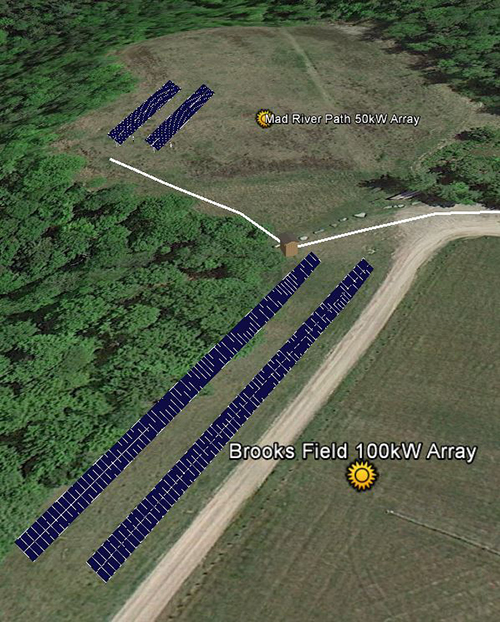
A 150kW solar array could cover Warren's school load and municipal load, "and it isn't really going to cost the town anything in the course of its life," Warren Select Board member Bob Ackland said at a meeting on Tuesday, December 10.
At that meeting, the board discussed the details of a financing plan for a solar array proposed by Nils Behn of Aegis Renewable Energy that's "pretty much tailored to our needs," select board chair Andy Cunningham said. By using a leasing company, the town would have no up-front costs to install the array and the project would never be cash-negative.
The proposed solar array would occupy an area behind Brooks Field at Warren Elementary School on a strip of land of about 40 feet by 300 feet between the road on the far side of the field and the forest behind it. The array would include 330 solar panels and produce just over 100kW of net-metered electricity.
According to Behn, once installed, the array would have an output of $0.21/kWh. That rate is set by the state and guaranteed for a minimum of 10 years, Behn explained, but with energy costs increasing, it's likely that the rate could increase to the town's benefit, rather than the other way around.
Currently, Warren's school load is $0.13/kWh and Warren's municipal load is $0.13/kWh. If 89 percent of the array output went to the school, as Behn recommends, it would cover 100 percent of its load. The remaining output would go toward covering the municipal load.
The town also has the option of installing a larger solar array, Behn said, that would offset the entire school load and "almost exactly offset the entire municipal load, within one percentage point." The larger solar array would include installing a second 50kW array on the Eaton Parcel, town-owned land that lies behind the proposed site of the 100kW array.
In a previous meeting about the project, public works director Barry Simpson proposed that the entire solar array be installed on land on the Eaton Parcel, as the proposed site of the 100kW array (the strip of land between the road on the far side of Brooks Field and the forest behind) is currently the only available space for overflow parking at the elementary school, as the septic system runs under almost all of its fields.
Due to the geography of the ridgeline and trees on the Eaton Parcel, any array placed there would receive less sunlight and, therefore, have a lower output, "but it's going to be a trade-off" either way, Simpson said, and installing the arrays on the Eaton Parcel would "allow for more flexibility."
At last Tuesday's meeting, however, one resident expressed support for the project but advocated against installing the array on land on the Eaton Parcel, which is "a close, accessible place ... to see nature," she said. Installing the array on the strip of land between the road on the far side of Brooks Field and the forest behind it makes sense because that area has already been developed, she said, and the array would represent another piece of "built infrastructure."
While the board has yet to decide on the exact size and location of the array, it has looked into several options for financing it, taking into account their inherent pros and cons. The final financing plan proposed by Behn is a 12-year lease with an interest rate of just under 4 percent.
Under the proposed plan, Behn's company would install the array at no up-front cost to the town. Warren would use the output money collected from the array to start making lease payments after one year. During that time, excess output money would be set aside to go toward a $200,000 balloon payment the town would make after 12 years. Behn estimates that by then, the town will have saved up approximately $30,000 to go toward the payment and the town will enter into a financing plan for the remaining amount.
Included in the financing plan, the town would also put aside $2,000 a year for any maintenance costs associated with the array, with more money set aside in the later years if an inverter fails and needs to be replaced. The town would take out its own insurance for the panels, which are guaranteed for 25 years but "could easily last 30," Behn said.
"Is there a risk to the project?" select board member Anson Montgomery asked. "Yes. But it's a small and manageable risk." By financing the array with a 12-year lease, "we're not putting ourselves out there ... so we're not going to reap the awards quite as quickly."
But "the baseline is, it's going to save the town money," Cunningham said of the array, and the board agreed that in an era of increasing dependence on fossil fuels, utilizing renewable energy sources such as solar is the right thing to do.
The board plans to vote on the final financing plan, size and location of the project at their next meeting (date to be determined).
{loadnavigation}





